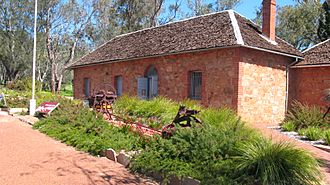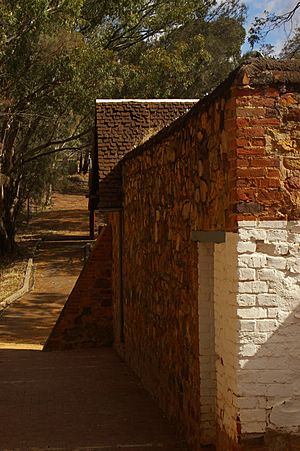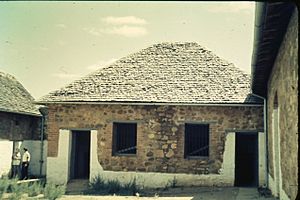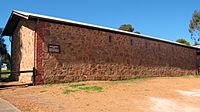Newcastle Gaol Museum facts for kids
Quick facts for kids Newcastle Gaol Museum |
|
|---|---|

Old Newcastle Gaol Museum
|
|
| General information | |
| Type | Prison museum |
| Location | Toodyay, Western Australia |
| Coordinates | 31°33′13″S 116°28′02″E / 31.5535°S 116.46710°E |
| Official name | Newcastle Gaol, Lock-up and Stables Group, Toodyay |
| Type | State Registered Place |
| Designated | 31 May 1996 |
| Reference no. | 2558 |
The Newcastle Gaol Museum is a fascinating place in Toodyay, Western Australia. It opened in 1962 and tells the story of the old prison. You can learn about famous escape artist Moondyne Joe and see the special cell where he was held. It's a great spot to explore history!
Contents
Exploring the Gaol's Past
In the early days, around 1832, the area was just starting to be settled. Police and judges were based in a town called York. Most problems involved people stealing farm animals.
Early Police and Justice
In 1840, Governor John Hutt created a special police group. This group, called the Native Police, worked with Aboriginal people. They were different from the civil police, who looked after the "white" settlers. John Drummond led this new force. He was friends with the Noongar people and patrolled the area with his Aboriginal troopers.
Samuel Pole Phillips became a local justice of the peace. This meant he helped the main judge with local legal matters. In 1842, the first government building was built in Toodyay. It was a barracks and stables for soldiers.
By 1854, Toodyay had several police groups. There were Mounted Police, Native Police, and Pensioner Guards. A new lockup, which was a small jail, was built in Toodyay. It had 12 cells and a high wall for an exercise yard. Many people ended up there because of drunkenness.
Convicts Arrive in Western Australia
In 1851, a ship carrying convicts, the Pyrenees, arrived. This meant Governor Charles Fitzgerald needed places to house them. So, "convict hiring depots" were set up in country areas. Michael Clarkson was in charge of the Toodyay depot.
At first, convicts stayed at the Toodyay Barracks. The Pensioner Guards, who were ex-soldiers, came with them. These guards were offered land to encourage them to move to the colony. They also helped as a special police force when needed.
Moving the Town and Building a New Gaol
Around 1860-1861, Toodyay faced many floods. Because of this, people decided to move the town to a new, higher location. This new place was called Newcastle, which is where Toodyay is today.
The police also moved to the new site. A judge suggested building a new gaol (jail) between the old and new towns. This would make it easier to bring people from the local inns to the cells.
Plans for a new gaol were drawn up by Richard Roach Jewell. The chosen spot was on Clinton Street in the new town of Newcastle.
Building the Newcastle Gaol
The Newcastle Gaol was built using timber from an old lockup. Convict labour was used for the construction. An ex-convict stonemason supervised the work. He sometimes complained that the unskilled workers made the job take longer.
Jewell's plan included a special security cell. This cell had timber lining and an iron bar for leg irons. The gaol we see today is smaller than first planned. It was finished in 1864 and started operating in 1865. It served as a state gaol until 1909.
In the 1930s, the Dorizzi family lived in the building. The sons even slept in the old cells! Sadly, three of these brothers died in World War II. Today, one cell is dedicated to them and all local service members who did not return home.
After the war, the building fell into disrepair for nearly 20 years. But in 1962, a restoration project began, and the museum was born.
What You Can See Today
Since 1962, the gaol has been a museum. The local government and the W.A. Tourist Bureau helped restore it. Grants have helped keep the building strong and stable. The museum is now officially recognized and managed by the Shire of Toodyay.
A professional curator works with volunteers to run the museum. The exhibits have gotten better over the years. You can visit the Moondyne Joe Gallery and the "Native" Cell. This cell display even won an award in 2013!
The main area often has temporary displays. Sometimes, you can even see a courtroom scene. Other parts of the museum show items from daily life during the settler era. Outside, there's old farm machinery. Across the road, you can see the restored 1891 Police Stable, the 1907 Police Lock-Up, and a very old shearing shed. There are also many horse-drawn carts to explore.
In 1983, the museum won an award from Museums Australia for its excellent educational programs.
The Police Stables
The stables across from the gaol were built in 1891. They were used by the police until 1955. These stables replaced an older timber building that burned down. The current building is made of stone with brick details. It has a corrugated iron roof.
The front of the building is solid stone with five small windows high up. Restoration of the stables started in the 1970s. Today, you can visit the stables as part of the Old Gaol Museum complex.




